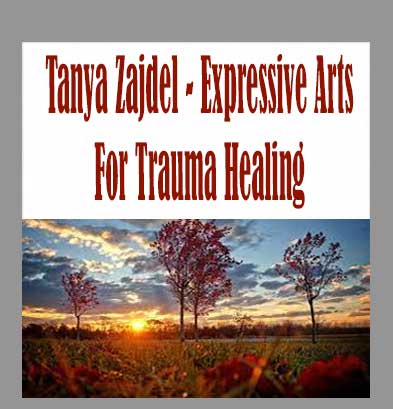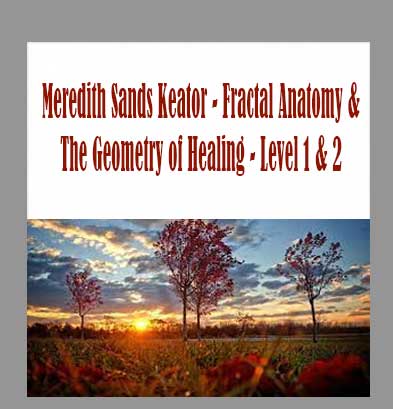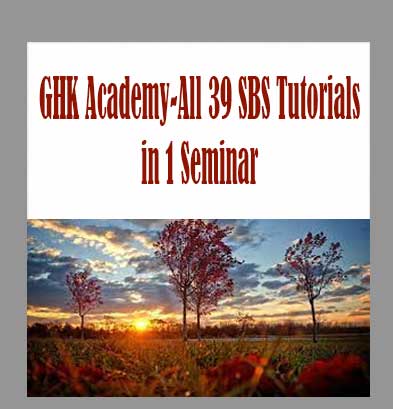Description
Tanya Zajdel – Expressive Arts For Trauma Healing download , Tanya Zajdel – Expressive Arts For Trauma Healing review , Tanya Zajdel – Expressive Arts For Trauma Healing free
Tanya Zajdel – Expressive Arts For Trauma Healing
Artistic expression can help the nervous system release stored trauma.
Join this online Expressive Arts Therapy Program with expert-guided, 10-minute therapeutic art exercises to support safely reprocessing trauma and to help to:
- Use creativity and self-expression to process loss and grief
- Increase neuroplasticity to reframe old memories
- Rewire patterns of fear, rumination, worry and anxiety
- Improve your mood, self-esteem, and self-awareness
- Establish a sense of safety and trust to express sensations and emotions
- Rediscover inner playfulness, vulnerability, and curiosity
“The task of therapy is not to eliminate suffering but to give a voice to it, to find a form in which it can be expressed.” – Stephen K. Levine
Conventional forms of therapy tend to rely on trauma being expressed verbally.
This can overlook how our fears, emotions, and memories are stored in our bodies and unconscious mind, which can make them difficult to put into words (van der Kolk, 2014).
The therapeutic uses of art offer a powerful way to safely process our trauma.
In the words of Natalie Rogers: “What is creative is frequently therapeutic. What is therapeutic is frequently a therapeutic process.”.
Through creative and meaningful art-making, our bodies are actively involved in expressing and transforming how we make sense of our experiences.
Art-making activities that can include finger painting, pottery, drawing, and collage, can support us to reintegrate our bodies and our minds to help reframe our past experiences in a new light (Cherry, 2021; Dexter, 2022; Malchiodi, 2003).
These empowering activities can give us the autonomy to communicate our innermost feelings in whichever way we see fit, changing the outcomes of our past into what we wish to see and feel (Malchiodi, 2020).
The therapeutic use of art can offer us a safe, non-judgmental, and personal setting to foster healing and growth.
It’s a practice that’s just for you – it’s a practice that we deserve.
There are many other benefits of art therapy. These include:
- The reduction of symptoms of depression (Cherry, 2021).
- Reduced feelings of stress (Dexter, 2022).
- Improved mood, self-esteem, and self-awareness (Dexter, 2022, Mayden, 2012).
- An easy tool to safely work through traumatic events and memories (Dexter, 2022).
- A new, exciting way to express ourselves and re-explore our inner light (Dexter, 2022).
In this program, Expressive Arts For Trauma Healing, we will guide you through gentle artistic techniques that can help you to express your identity, improve your resiliency, and build a stronger relationship with yourself.
We’ll also discuss the potential healing benefits of art in our six expert-led theory modules.
By the end of the program, we hope that you or your clients will have discovered safe and practical techniques that can be incorporated into your trauma healing toolbox.
Natalie Rogers sums it up as an empowering process that “fosters release, self-understanding, insight and awakens creativity and transpersonal states of consciousness.”
Introducing Expressive Arts For Trauma Healing: Therapeutic Techniques To Rediscover Your Creative Self
Seven Therapeutic Art Techniques:
Technique 1: Finding Safety
Explore an art therapy technique to help develop a sense of trust. This can allow the art to serve as a safe container to explore thoughts and feelings to feel safe and grounded.
Technique 2: Channeling Permission To Trust
Explore an art therapy technique to help establish a sense of trust. In this exercise, the art serves as a safe space to explore thoughts and feelings about trusting oneself and trusting others.
Technique 3: Uncovering Support Systems Through Circle Drawing
Learn to create a safe vessel to express thoughts and emotions to strengthen feelings of better connection and support from friends, mental health professionals, family, and yourself.
Technique 4: The Paper Bead Technique
Explore an art therapy technique to help with the concept of sharing power. Use this as a safe space to explore thoughts and feelings about accepting and offering power.
Technique 5: Harnessing Resiliency With Watercolor
Explore an art therapy technique to help establish a sense of resiliency. In this exercise, the art serves as a safe vessel to explore thoughts and feelings around harnessing resilience and strength.
Technique 6: Box Decoration For Agency
Engage in a hands-on box decoration technique to help focus on the inner and outer self. Learn to use art to explore thoughts and feelings about integrating your inner and outer experiences.
Technique 7: Expressing Culture And Self-Identity Through Abstract Drawing
Engage in an abstract drawing to connect with feelings associated with your culture and explore thoughts and feelings around honoring cultural aspects of self-identity.
Bonus Therapeutic Art Techniques
- Bonus Technique 1: Intrusive Thoughts Container
- Bonus Technique 2: Visualizing Wave Breath
- Bonus Technique 3: Mandala Vision Map
Six Expert-Led Modules:
Module 1: An Introduction To Art Therapy As A Practice With Trudy Kim (32-min)
- The difference between art making and art therapy
- The use of art therapy and brain change
- The do’s and don’t of facilitating art therapy
- Art therapy as an assessment and therapeutic tool
- Misconceptions around art therapy
Module 2: Exploring Art Therapy Techniques With Trudy Kim (18-min)
- Planning the facilitation of art therapy
- Therapeutic art techniques for survivors and clinicians to try
- Considerations for trauma-informed art therapy
- The history of art theory
- Distinguishing art therapists’ credentials
- The healing factors of art therapy and its impact on brain functioning
Module 3: The History, Components, And Approach Of Phototherapy With Behzad Bernous (25-min)
- Defining therapeutic photography
- Explore the history of therapeutic photography
- Discover the psychology behind photography
- Utilizing creative expression in therapeutic photography
Module 4: Phototherapy And Healing Trauma With Behzad Bernous (25-min)
- Discover how phototherapy can help heal trauma
- Explore examples of phototherapy in practice
- References and resources for further study
Module 5: The Foundations of Art Therapy With Rory O’Neil (31-min)
- Defining art therapy
- The required training to be an art therapist
- Different ways art therapy can help the therapeutic process
- Misconceptions about art therapy
- Who can benefit from art therapy
- The various techniques used in art therapy
Module 6: The Processes of Art Therapy With Rory O’Neil (24-min)
- Differentiating between ‘art therapy’ and ‘therapeutic art’
- The different mediums used in art therapy
- How art and creativity assist in trauma healing
- Safe therapeutic art exercises to engage in at home
- Art and the reconnection to the self
Meet The Experts
Tanya Zajdel
RN, PSYCHIATRIC NURSE, FOUNDER OF REWIRE TRAUMA THERAPY
Tanya’s work with trauma healing and survivorship has been featured at the Tribeca Film Festival, CBC News, Vox Tablet and Iheart Radio.
Tanya is a mental health worker, a women’s health nurse, and a published feminist author. Tanya focuses primarily on creating programs that facilitate trauma healing through creating new neural connections in the brain called ‘neuroplasticity exercises’.
Her techniques combine various proven therapies to repair and reset the nervous system after trauma including somatic therapy, yoga, drama therapy, dance therapy, CBT, qigong, EMDR, vagal toning, authentic movement, and a combination of expressive, creative art therapies.
Trudy Kim
BOARD-CERTIFIED ART THERAPIST (ATR-BC, LICENSED PROFESSIONAL COUNSELOR (LPC), BOARD-CERTIFIED COUNSELOR (NCC)
Trudy has been a board-certified art therapist (ATR-BC) since 2005 and a Licensed Professional Counselor (LPC) in the state of Virginia since 2007. She has also been a board-certified counselor (NCC) through the National Board of Certified Counselors (NBCC) since 2008.
In 2020, Trudy became a Certified Clinical Anxiety Treatment Professional (CCATP), applying neuropsychologically-informed Cognitive Behavioral Therapy to treat anxiety, panic, and worry. And in 2021, she become a Trauma Center Trauma Sensitive Yoga Facilitator (TCTSY-F), adapting evidence-based, body-based yoga forms to assist those with chronic, treatment-resistant PTSD.
Behzad Bernous
LICENSED CLINICAL PSYCHOLOGIST
Behzad Bernous is a Licensed clinical psychologist, licensed Marriage and Family Therapist, and Certified Life Coach (LC).
Dr. Bernous is a professor of psychology and runs his private practice in Newport Beach, CA. Dr. Bernous is an active member of the Mental Health Society and hosted several radio shows and TV shows. Dr. Bernous has extensive knowledge and experience in psychology and art which enables him to be an avid observer, a good listener, as well as a creative solution finder.
Rory O’Neill Schmitt
PH.D. AND AUTHOR
Rory O’Neill Schmitt, Ph.D. is an author, educator, and filmmaker. She has written Navajo and Hopi Art in Arizona (2016), New Orleans Voodoo (2019), and is writing her third book with Arcadia Publishing: Edgar Degas in New Orleans.
Currently manager of faculty development at the University of Southern California, she previously worked as a board-certified art therapist and director and served as Arizona Art Therapy Association president. She earned her Ph.D. in Curriculum Studies from Arizona State University and her master’s in Art Therapy from the School of Visual Arts.
Jooske Honig
HOLISTIC DRAWING THERAPIST, ACROYOGA INSTRUCTOR
Jooske Honig is a qualified holistic drawing therapist, a certified intuitive energy reader, a trained holistic masseuse, an energetic bodyworker, and an Acroyoga instructor. She holds a certificate in Mindful Somatic approaches to trauma Therapy and non-violent communication with children.
She has had her own practice In-Spiral since 2016, and works online in a beautiful studio; Aotearoa Embodiment Collective is based in the center of Dunedin, New Zealand.
Frequently Asked Questions:
- Innovative Business Model:
- Embrace the reality of a genuine business! Our approach involves forming a group buy, where we collectively share the costs among members. Using these funds, we purchase sought-after courses from sale pages and make them accessible to individuals facing financial constraints. Despite potential reservations from the authors, our customers appreciate the affordability and accessibility we provide.
- The Legal Landscape: Yes and No:
- The legality of our operations falls into a gray area. While we lack explicit approval from the course authors for resale, there’s a technicality at play. When procuring the course, the author didn’t specify any restrictions on resale. This legal nuance presents both an opportunity for us and a boon for those seeking budget-friendly access.
- Quality Assurance: Unveiling the Real Deal:
- Delving into the heart of the matter – quality. Acquiring the course directly from the sale page ensures that all documents and materials are identical to those obtained through conventional means. However, our differentiator lies in going beyond personal study; we take an extra step by reselling. It’s important to note that we are not the official course providers, meaning certain premium services aren’t included in our package:
- No coaching calls or scheduled sessions with the author.
- No access to the author’s private Facebook group or web portal.
- No entry to the author’s exclusive membership forum.
- No direct email support from the author or their team.
We operate independently, aiming to bridge the affordability gap without the additional services offered by official course channels. Your understanding of our unique approach is greatly appreciated.
- Delving into the heart of the matter – quality. Acquiring the course directly from the sale page ensures that all documents and materials are identical to those obtained through conventional means. However, our differentiator lies in going beyond personal study; we take an extra step by reselling. It’s important to note that we are not the official course providers, meaning certain premium services aren’t included in our package:
Refund is acceptable:
- Firstly, item is not as explained
- Secondly, Item do not work the way it should.
- Thirdly, and most importantly, support extension can not be used.
Thank you for choosing us! We’re so happy that you feel comfortable enough with us to forward your business here.








Reviews
There are no reviews yet.